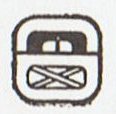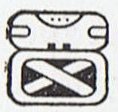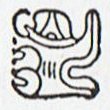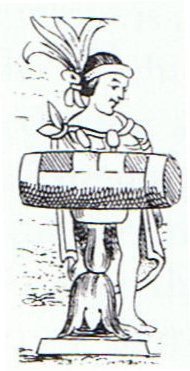6. On the other hand the path of Sun could be said to continue past Ga7-10. From November 19 (323) to December 31 there are 42 days.
I guess we could be inspired by Toliman (α Centauri) and see the end of the year north of the equator as finished at Ga8-18 (with a great tagata at the back side in Ga8-19).
I have reduced the right ascension days for the stars with 1 in order to reflect the dates given. Ga6-17 is glyph 157 counted from Ga1-1 and Ga8-18 is number 221 (= 157 + 64). 157 is not an arbitrary number, it probably signifies 'half π'. 471 = 314 + 157. 61 * 6 = 366 and 72 years ago Ga6-16 presumably was meant to be at October 27, day 300 in our calendar. If a year has 10 months with 30 days in each, then Ga6-16 could represent the last day of such a year. We should recall from Allen and my comments: ... Kaus Borealis, the Northern (part of the) Bow, was Al Tizini's Rā'i al Na'āïm, the Keeper of the Na'ams, the uncertainty as to the meaning of which has already been noticed; but Kazwini evidently understood by it Ostriches, for in his list it is, with the stars μ, Al Thalimain, plainly meaning these desert birds. With the same stars it may have been the Akkadian Anu-ni-tum, said to have been associated with the great goddess Istar ... ... Another mystery is evidently solved here too, viz. the star name Toliman (α Centauri). I think it is a corruption of the Arabic Al Thalimain, The Ostriches. The ostrich is a peculiar bird because it keeps its head down in the sand, unable to see anything. I suspect it illustrates how Sun late in the year is moving closer and closer to the horizon, threatening to disappear completely - which it does in midwinter for an observer close to the pole. The ostrich has a very great egg which could symbolize Sun at winter solstice ... The glyph type hanau (birth) has at Toliman a maro string hanging down in front, a sign which probably means 'border line at the end'. There is no other hanau+maro glyph in the G text. In Ga8-18 there is no negation of the birth sign by a hanging maro and day 365 can be compared to night 29 in the month - a day of birth. 472 - 222 (= 471 - 221) = 250 (the same number as that for Antares, if we count days from the current spring equinox north of the equator). Thus I have suggested there is a double final for Old Sun, first at Toliman and 64 days later at day 365. We can compare with how there are 65 days from the beginning of the 16th Mayan month Pax to the end of the year:
October 28 is day 301 and thus it corresponds to the first day of Pax. This was the day when Toliman rose heliacally 72 years ago. ... The [tun] glyph is nearly the same as that for the month Pax ... except that the top part of the latter is split or divided by two curving lines. Brinton, without referring to the Pax glyph, identified the tun glyph as the drum called in Yucatec pax che (pax 'musical instrument'; che < *te 'wooden). Yucatec pax means 'broken, disappeared', and Quiche paxih means, among other things, 'split, divide, break, separate'. It would seem that the dividing lines on the Pax glyph may have been used as a semantic/phonetic determinative indicating that the drum should be read pax, not tun ... Thus, one may expect that this glyph was used elsewhere meaning 'to break' and possibly for 'medicine' (Yuc. pax, Tzel., Tzo. pox) ... (cfr at Toki)
The first Mayan months could then correspond to those 80 days which end at March 21:
If we assume the G text covers also these dates, then we should put January 1 at a glyph which is 80 positions earlier than Rogo in Gb6-26. But I doubt it. If Sun is not present - not even north of the equator - it would be nonsense to talk about heliacal risings of stars. | |||||||||||||||||||||||||||||||||||||||||||||||||||||||||||||||||||||||||||||||||||||||||||||||||||||||||||||||



























